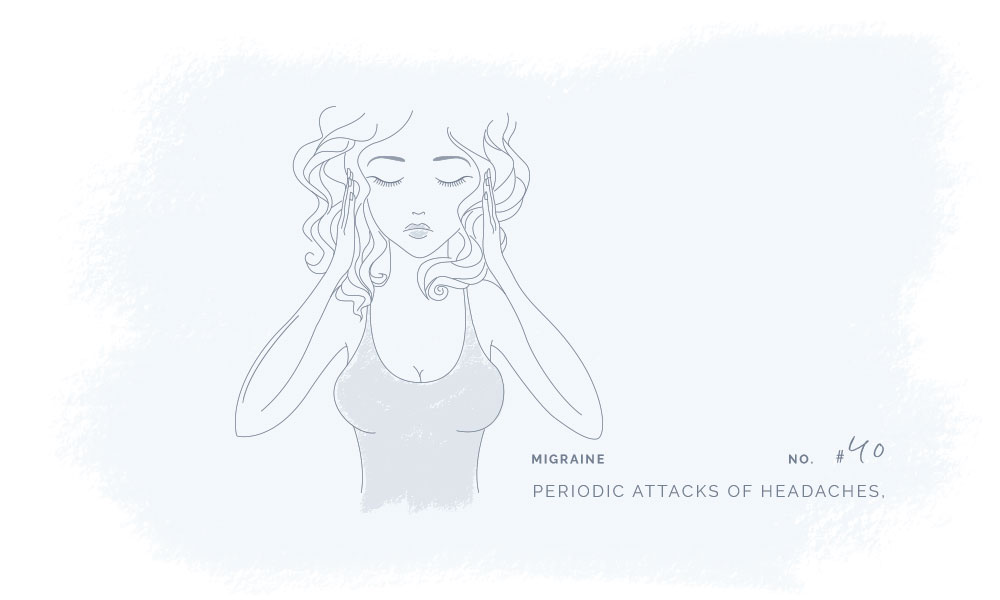Migraine
Category
Neurological
REVIEWED BY
Our Biomedical Scientist
Reviewed based on
Literature Discussion & Clinical Trials
Last update
November 2020

What is Migraine
Migraine is a medical condition that leads to periodic attacks of headaches on one or both sides of the head. The attacks may be accompanied by nausea, purging, and increased sensitivity to light and sound. Migraine attacks can last for hours to days and be so severe that it interferes with daily functioning.1
Symptoms
Migraine’s symptoms can be divided into 4 stages; prodrome, aura, attack, and post-drome, however, not everyone suffering from migraine experiences all stages. Today, medications can prevent and/or relieve the pain of some migraine attacks.1
Prodrome
Some people will experience warning symptoms of an upcoming migraine (one or two days).
It includes:
- Constipation
- Specific food cravings
- Stiffness in the neck
- Increased urination or thirst
- Frequent yawning
- Unusual mood changes ranging from depression to euphoria
Aura
For a group of people suffering from migraines, an aura may be experienced before or during migraines. Auras can include vision disturbance, stings in limbs or one side of the face, and difficulty speaking. An aura is a reversible symptom of the nervous system. Each symptom starts gradually and continues for 20 to 60 minutes.
Migraine aura can have symptoms such as:
- Pinching sensations in limbs
- Difficulty hearing sounds and music
- Numbness in one side of the body or face
- Difficulty speaking
- Uncontrollable movements
Attack
Without treatment, migraine attacks can last from 4 to 72 hours. The occurrence of migraines can differ from person to person. It is possible to experience migraines several times a month or they might occur rarely. The most common symptoms of a migraine attack are:
- Severe pulsing sensation or throbbing pain in (usually) one side of the head
- Nausea and purging
- Extreme sensitivity to light and sound
Post-drome
After a migraine attack, the state of the post-drome occurs where one may feel drained, confused, elated, and tired. In this state, sudden head movement may cause the pain to return briefly.
Cause
The exact causes of migraines are not yet fully known. However, it has been suggested that genetics and environmental factors might be involved in the development of this condition.
Another causes that might increase the development of migraine is changes in the brainstem and its interactions with the trigeminal nerve, a major pain pathway. Brain chemical imbalance, including serotonin, which plays a role in regulating pain in the nervous system, might also be a possible cause for increased risk of migraine. Currently, researchers are examining serotonin involvement in migraines. Other neurotransmitters such as calcitonin gene-related peptide (CGRP) are involved in migraine pain.1
Some of the biological and environmental factors that may trigger migraine are the following:
- Sex
Women are 3 times more likely to develop migraine - Hormones change and the female cycle
The level of estrogen may often trigger migraine around menstrual periods, pregnancy, and menopause - Drinks with alcohol and/or caffeine
Alcohol, especially wine and drinks with a high level of caffeine - Stress
High-stress levels in professional – and personal life - Sensory stimuli
Bright lights (lamps or the sun), loud sounds, and strong smells - Abruption in sleeping pattern
Jetlag, too much or too little sleep - Weather conditions
Barometric pressure or change in weather - Food intake
Certain types of food such as aged cheeses, processed food, highly salty food, or fasting + food additives
The connection between Cannabinoids & Migraine
Studies find that CBD and THC may have great therapeutic potential and may be used to help treat Migraine. CBD and THC are well-known cannabinoids, however, they do not have the same psychoactive effects. THC is psychoactive while CBD does not possess psychoactive effects. According to WHO guidelines, the cannabidiol CBD is generally well tolerated with a good safety profile.
Recent research supports the potential of cannabinoids as they may have potent anti-emetic ,, analgesic and anti-inflammatory properties that may relieve symptoms.2
In addition, cannabinoids may be beneficial in the acute and prophylactic treatment of migraine pain.3
The literature discussion is an overview of the published results from scientific studies investigating if and how cannabinoids can be beneficial in the treatment of Migraine. The overview will be updated regularly to ensure the newest and most accurate information.
Cannabinoids properties may be beneficial in the treatment of migraine
Cannabinoids exhibit anticonvulsive, analgesic, antiemetic, and anti-inflammatory activities which may be used to treat migraine.3
In rats, CSD amplitude, duration, and propagation velocity were inhibited by THC.4
Clinical trials are research studies that examine new treatments and evaluate their effects on human health outcomes.
Cannabinoids was shown to reduce migraine frequency
In one study, migraine headache frequency was shown to be reduced from 10.4 to 4.6 per month upon treatment with medical cannabis.5
- https://www.mayoclinic.org/diseases-conditions/migraine-headache/symptoms-causes/syc-20360201
- Baron, E.P., Et Al., (2018). ” Patterns of medicinal cannabis use, strain analysis, and substitution effect among patients with migraine, headache, arthritis, and chronic”. https://www.ncbi.nlm.nih.gov/pmc/articles/PMC5968020/
- Leimuranta, Pi., Et Al., (2018). “Emerging Role of (Endo)Cannabinoids in Migraine”. https://www.ncbi.nlm.nih.gov/pmc/articles/PMC5928495/
- Kazemi, H., Et Al., (2012). “Effect of Cannabinoid Receptor Activation on Spreading Depression”. https://www.ncbi.nlm.nih.gov/pmc/articles/PMC3586901/
- Rhyne, D.N., Et Al., (2016). ” Effects of Medical Marijuana on Migraine Headache Frequency in an Adult Population”. https://pubmed.ncbi.nlm.nih.gov/26749285/
CANNABINOIDS & RECEPTORS
Below you find the plant cannabinoids, cannabinoid receptors, and endocannabinoids that are associated with the potential therapy.
If you have any further information relevant to the connection between Migraine and cannabinoids or find any of the information inaccurate, outdated or incomplete please contact us here.

